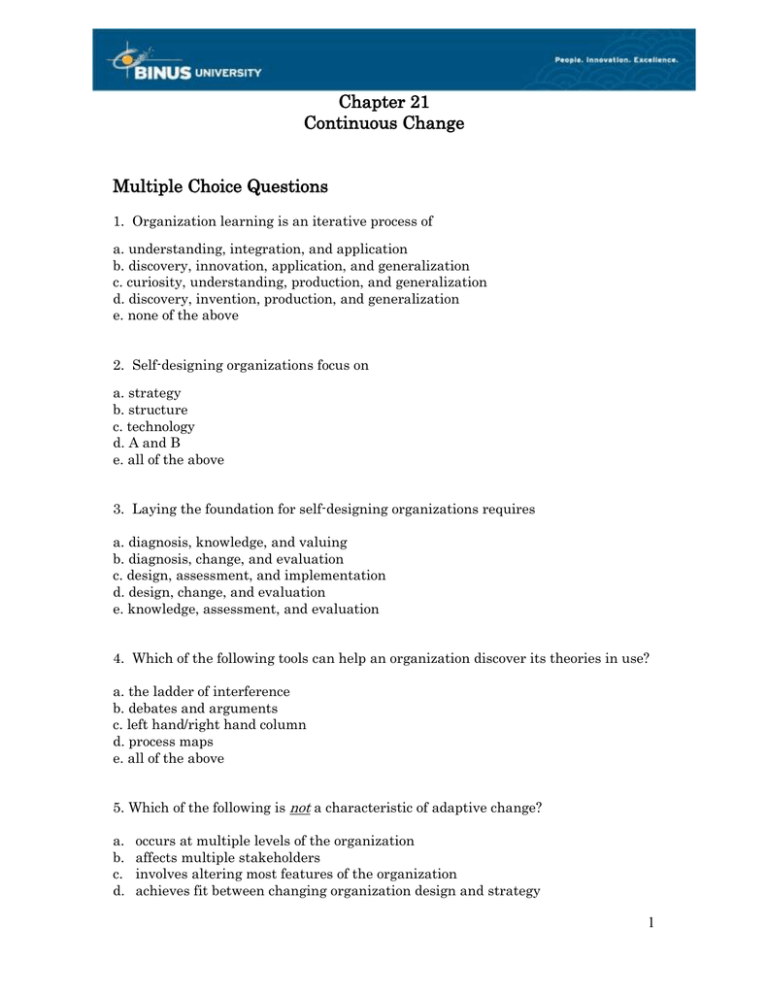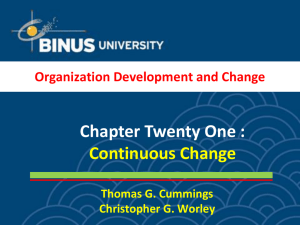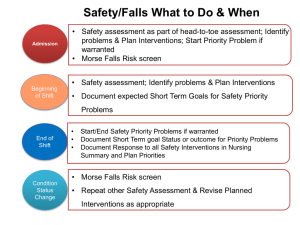Chapter 21 Continuous Change Multiple Choice Questions
advertisement

Chapter 21 Continuous Change Multiple Choice Questions 1. Organization learning is an iterative process of a. understanding, integration, and application b. discovery, innovation, application, and generalization c. curiosity, understanding, production, and generalization d. discovery, invention, production, and generalization e. none of the above 2. Self-designing organizations focus on a. strategy b. structure c. technology d. A and B e. all of the above 3. Laying the foundation for self-designing organizations requires a. diagnosis, knowledge, and valuing b. diagnosis, change, and evaluation c. design, assessment, and implementation d. design, change, and evaluation e. knowledge, assessment, and evaluation 4. Which of the following tools can help an organization discover its theories in use? a. the ladder of interference b. debates and arguments c. left hand/right hand column d. process maps e. all of the above 5. Which of the following is not a characteristic of adaptive change? a. b. c. d. occurs at multiple levels of the organization affects multiple stakeholders involves altering most features of the organization achieves fit between changing organization design and strategy 1 e. requires little on-site modifications or learning 6. Organization learning (OL) interventions are typically associated with a. b. c. d. management and leadership teams information systems and technology departments human resources and social processes none of the above 7. The learning organization is not characterized by _____________. a. b. c. d. culture that supports openness, creativity among members acquisition and sharing of new skills and knowledge among members structures that emphasize individual unit performance leaders that exhibit openness and risk taking required for learning 8. Which of the following are techniques of OD interventions that identify organization member theories-in-use and reveal assumptions? a. b. c. d. e. left-hand, right-hand column ladder of inference action map dialogue all of the above 9. Knowledge management interventions usually begin by __________________. a. identifying the types of knowledge that create the most value for the organization b. bringing together members and experts to generate new knowledge c. putting knowledge into forms that the organization can use readily d. developing ways for organization members to gain access to necessary knowledge e. A and B 10. Built-to-change interventions are best suited for organizations that are ___________. a. b. c. d. experiencing a change in ownership facing a rapidly changing environment performing poorly compared to last year’s profits operate in a stable market 2 11. Which of the following organization structures best support Built-to-Change interventions? a. b. c. d. e. formal, hierarchical flat, lean, flexible matrix, process, and network A and C B and C 12. The term “pursue proximity” in the Built-to-change intervention can best be described as a. b. c. d. placing the organization closer to its desired state predicting the future of the organization developing scenarios of possible and desired future environments pursuing steps necessary for change 13. Which of the following is not a key to making strategic adjustment a standard practice? a. b. c. d. sharing relevant information widely pushing decision making downward having standardized, stable reward systems giving members relevant skills and knowledge True/False Questions 14. Self designing organizations are well suited for stable, predictable markets and environments. 15. Codification and personalization are techniques used on organization learning interventions. 16. Organization learning is similar to individual learning. 17. Knowledge management is more concerned with developing organizational capabilities while organization learning is more concerned with technical issues, such as how to store organization experience. 18. The most prevalent form of learning in organizations is single-loop learning which is focused on improving the status quo. 3 19. Organization learning is an active process based on interpretive models of change where members interact and learn from their actions. 20. The ladder of inference can help organization members understand why their actions may be ineffective. 21. Built-to-change interventions are characterized by selecting and developing leaders and members, who are quick learners, take initiative and thrive on change. 22. Once organization learning interventions are underway, organization members must be willing to publicly test the effectiveness of their learning strategies. Essay Questions 23. How can an OD practitioner help an organization become self designing? 24. Describe how an organization can use “double-loop learning” to improve performance. 25. Compare and contrast the organization learning interventions with knowledge management interventions. Discuss the benefits of each. 26. How is the Built-to-Change intervention designed to promote a sustained competitive advantage? 4






